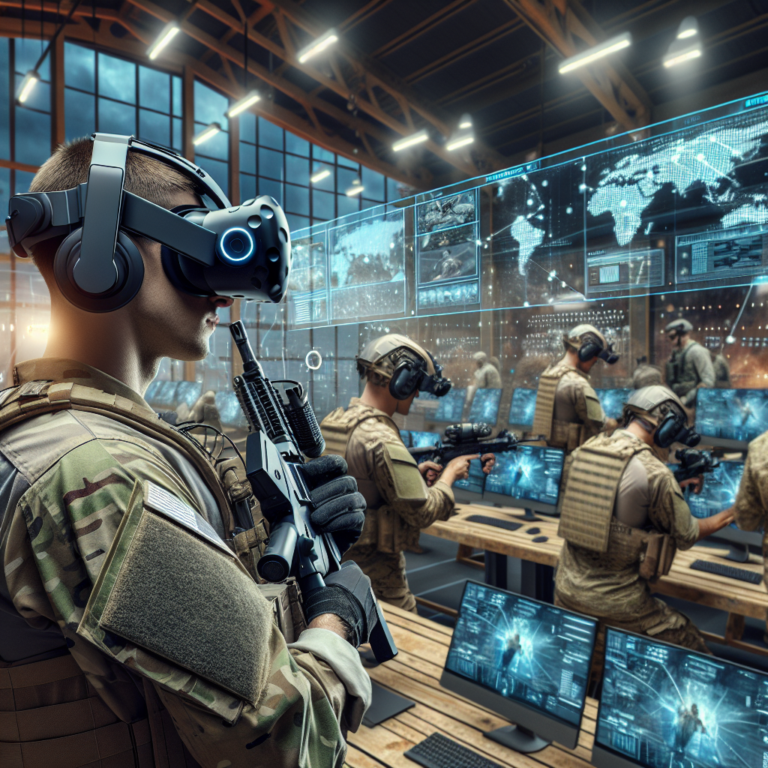Transforming Military Preparedness: The Power of Immersive Technologies in Defense
The Revolution of Military Training
In an age where technology drives innovation, the military sector is rapidly harnessing the potential of immersive technologies to enhance military training and simulations. This transformative approach not only makes training more effective but also prepares soldiers for real-world scenarios in ways that traditional methods simply cannot. From virtual reality (VR) to augmented reality (AR) to simulation software, these technologies are reshaping how defense organizations prepare their personnel.
The Immersive Training Landscape
Immersive technologies encompass a variety of tools and methodologies that create realistic, interactive environments for training purposes. These technologies allow military personnel to engage with simulated combat scenarios, management situations, and tactical missions without the risks associated with live exercises. Let’s delve deeper into the key components of immersive training:
1. Virtual Reality (VR) Training
Virtual Reality immerses users in a completely computer-generated environment, offering a highly realistic experience that can replicate battles, tactical scenarios, or base operations. Key advantages of VR training include:
- Risk-free Environment: Soldiers can engage in combat simulations without facing the dangers of actual battlefield scenarios.
- Immediate Feedback: Instructors can provide real-time performance assessments as trainees navigate virtual challenges.
- Customizable Scenarios: The ability to tailor training environments to specific missions or threats enhances preparedness.
2. Augmented Reality (AR) Tools
Augmented Reality overlays digital information onto the physical world, allowing soldiers to interact with their actual surroundings while obtaining critical data. AR applications in military training include:
- Enhanced Situational Awareness: Troops can view essential mission data without losing focus on their immediate environment.
- Real-time Strategy Development: Commanders can visualize tactical plans on the field using AR headgear and applications.
- Collaboration and Communication: AR can facilitate better communication between ground troops and command centers through shared visualizations.
3. Simulation Software
This method incorporates a mix of mechanics to recreate combat and operational scenarios. Simulation software can be employed for:
- Weapon Systems Training: Personnel can learn the intricacies of operating various weapons without any physical risk or resource consumption.
- Logistics and Strategy Exercises: Commanders engage in complex operational maneuvers while responding to evolving situations.
- Crisis Response Drills: Soldiers can participate in realistic exercises to foster teamwork and decision-making in high-stress environments.
The Benefits of Immersive Technologies in Defense
Beyond just enhancing training effectiveness, immersive technologies offer a plethora of benefits to military organizations. Here are some of the most impactful advantages:
1. Cost-Efficiency
While the initial investment in immersive technologies may be high, the long-term savings can be substantial. Simulation and training without the need for physical resources reduces expenditures associated with live training exercises.
2. Scalability
Immersive training can be easily scaled to accommodate any number of personnel, making it an ideal solution for military units of all sizes. Whether training a small team or an entire battalion, immersive technologies can adapt to meet the training demand.
3. Improved Retention Rates
Studies have shown that trainees remember up to 75% of what they experience in an immersive environment, compared to just 10% from lectures. Interactive engagement enhances learning retention, which is crucial for military personnel who need to remember vital skills and procedures in high-pressure situations.
4. Enhanced Collaboration
Immersive technologies facilitate collaboration between soldiers, instructors, and command units, fostering teamwork in a controlled environment. This capability is vital for missions requiring coordinated efforts across different units and abilities.
Real-World Applications: Case Studies
As the military continues to adopt immersive technologies, notable success stories highlight their impact:
1. U.S. Army’s Synthetic Training Environment (STE)
The STE utilizes VR and AR technologies to create a cloud-based training environment for soldiers, enabling them to train anywhere in the world. This initiative streamlines training execution while ensuring soldiers remain combat-ready, even during down times.
2. United Kingdom’s Defence Science and Technology Laboratory (DSTL)
Utilizing AR technology, the DSTL has developed systems that allow troops to visualize data in real-time during operations. This has proven invaluable for decision-making, strategy refinement, and effective military operations.
3. Flight Simulation Programs
Countries globally are adopting realistic flight simulators that mimic environmental conditions and flight scenarios. These programs reduce the risk involved in training pilots, allowing them to log critical flight hours in controlled environments.
Challenges of Implementing Immersive Technologies
Despite the multitude of benefits, the integration of immersive technologies in military training is not without challenges:
- Initial Costs: High setup and development costs can deter defense organizations from adopting immersive solutions.
- Training Personnel: Effective operation of these sophisticated systems requires trained personnel who can manage and instruct others in their use.
- Technological Advancements: Rapid evolution in immersive tech may require constant updates and training, complicating long-term implementation.
The Future of Military Training
The future of military training looks incredibly promising with the emergence of immersive technologies. As defense organizations worldwide invest in these innovations, we can expect a shift toward more effective and efficient training methods. Building a future-ready military relies on incorporating cutting-edge technologies to prepare personnel for the challenges of modern warfare. This not only enhances individual capabilities but also fortifies the operational readiness of defense forces globally.
As immersive technologies continue to evolve, the military is poised to leverage these advanced tools to maintain their strategic edge in an increasingly complex world. Welcome to the future of defense – where training meets technology, and innovation fuels preparedness! 🚀




0 Comments